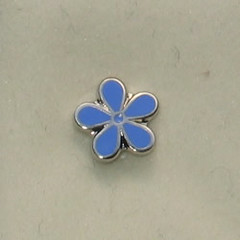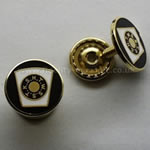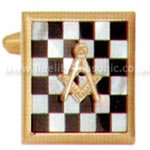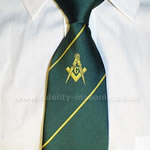Forget-me-not (Vergissmeinnicht)

Forget-me-not (Vergissmeinnicht)
Originally uploaded by Fidelity Masonic Supplies.
Purchase this badge.
The Forget-Me-Not (Das Vergissmeinnicht)
The Story Behind This Beloved Emblem Of The Craft in Germany
In early 1934, soon after Hitler's rise to power, it became evident that Freemasonry was in danger. In that same year, the "Grand Lodge of the Sun" (one of the pre-war German Grand Lodges, located in Bayreuth) realizing the grave dangers involved, adopted the little blue Forget-Me-Not flower as a substitute for the traditional square and compasses. It was felt the flower would provide brethren with an outward means of identification while lessening the risk of possible recognition in public by the Nazis, who were engaged in wholesale confiscation of all Masonic Lodge properties. Freemasonry went undercover, and this delicate flower assumed its role as a symbol of Masonry surviving throughout the reign of darkness.
During the ensuing decade of Nazi power a little blue Forget-Me-Not flower worn in a Brother's lapel served as one method whereby brethren could identify each other in public, and in cities and concentration camps throughout Europe. The Forget-Me-Not distinguished the lapels of countless brethren who staunchly refused to allow the symbolic Light of Masonry to be completely extinguished.
When the 'Grand Lodge of the Sun' was reopened in Bayreuth in 1947, by Past Grand Master Beyer, a little pin in the shape of a Forget-Me-Not was officially adopted as the emblem of that first annual convention of the brethren who had survived the bitter years of semi-darkness to rekindle the Masonic Light.
At the first Annual Convent of the new United Grand Lodge of Germany AF&AM (VGLvD), in 1948, the pin was adopted as an official Masonic emblem in honor of the thousands of valiant Brethren who carried on their masonic work under adverse conditions. The following year, each delegate to the Conference of Grand Masters in Washington, D.C., received one from Dr. Theodor Vogel, Grand Master of the VGLvD.
Thus did a simple flower blossom forth into a symbol of the fraternity, and become perhaps the most widely worn emblem among Freemasons in Germany; a pin presented ceremoniously to newly-made Masons in most of the Lodges of the American-Canadian Grand Lodge, AF&AM within the United Grand Lodges of Germany. In the years since adoption, its significance world-wide has been attested to by the tens of thousands of brethren who now display it with meaningful pride.
An alternative interpretation is:
In the years between WW1 and WW2 the blue forget-me-not was a standard symbol used by most charitable organizations in Germany, with a very clear meaning: "Do not forget the poor and the destitute". It was first introduced in German Masonry in 1926, well before the Nazi era, at the annual Communication of the Grand Lodge "Zur Sonne", in Bremen, where it was distributed to all the participants. That was a terrible time in Germany, economically speaking, further aggravated in 1929 following that year's "Great Depression". That economic situation, by the way, contributed a lot to Hitler's accession to power. Very many people depended on charity, some of which was Masonic. Distributing the forget-me-not at the Grand Lodge Communication was meant to remind German Brethren of the charitable activities of the Grand Lodge.
In 1936 (Hitler was already in control since 1933) the "Winterhilfswerk" (a non- Masonic winter charity drive) held a collection and used and distributed the same symbol, again with its obvious charitable connotation. Some of the Masons who remembered the 1926 Communication --and the forget-me-not-- possibly also wore it later as a sign of recognition. We have no evidence of that and its general signification still was charity, but not specifically Masonic charity. Moreover it rapidly became quite impossible to risk wearing anything but Nazi pins. So there were probably only a very few Brethren wearing the forget-me-not, and probably only for a brief time, until wearing any non-Nazi pins became suspect. There is absolutely no record of the pin, or the flower, ever having been worn during the war (that is after 1939), even less in concentration camps, as the legend also goes.
In 1948 Bro. Theodor Vogel, Master of the Lodge "Zum weißen Gold am Kornberg", in Selb (then in Western-occupied Germany), remembered the 1926 and 1936 pin, had a few hundred made and started handing it out as a Masonic symbol wherever he went. When Brother Vogel was later elected GM of the Grand Lodge AFuAM of Germany and visited a Grand Masters' conference in Washington, DC, he distributed it there too, and this was the way it first came to the USA.
Its sudden popularity caused many manufacturers, some Masonic, some not, to pounce upon the occasion and sell the pin all over the world, with a variety of rather contrived and imaginative notes of explanation. The pin is nowadays quite well-known, as are the legends written about its origin, purpose and use... Which does not deter after all from the new message it carries today, through its authors' imagination if not through rigorous historical record...










3 Comments:
ur website rocks
yeah
timothy
Post a Comment
<< Home